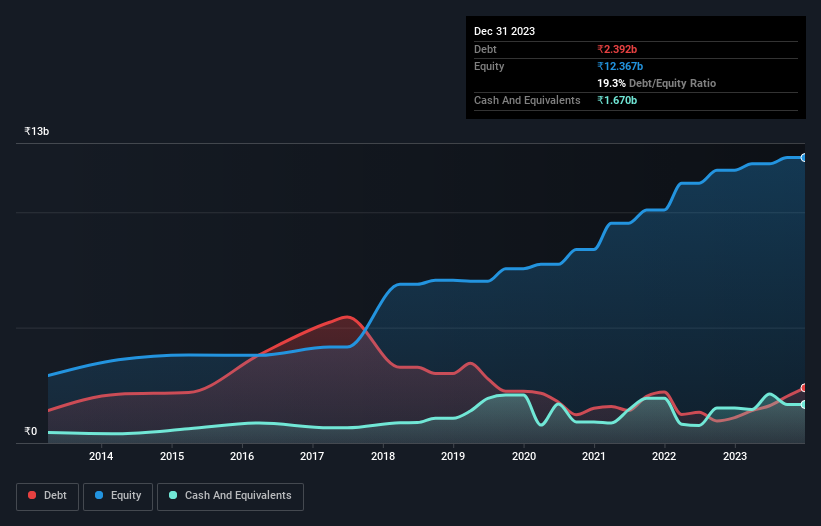These 4 Measures Indicate That GTPL Hathway (NSE:GTPL) Is Using Debt Extensively
Some say volatility, rather than debt, is the best way to think about risk as an investor, but Warren Buffett famously said that 'Volatility is far from synonymous with risk.' So it seems the smart money knows that debt - which is usually involved in bankruptcies - is a very important factor, when you assess how risky a company is. We note that GTPL Hathway Limited (NSE:GTPL) does have debt on its balance sheet. But the more important question is: how much risk is that debt creating?
What Risk Does Debt Bring?
Debt assists a business until the business has trouble paying it off, either with new capital or with free cash flow. Part and parcel of capitalism is the process of 'creative destruction' where failed businesses are mercilessly liquidated by their bankers. However, a more frequent (but still costly) occurrence is where a company must issue shares at bargain-basement prices, permanently diluting shareholders, just to shore up its balance sheet. Of course, plenty of companies use debt to fund growth, without any negative consequences. When we think about a company's use of debt, we first look at cash and debt together.
Check out our latest analysis for GTPL Hathway
How Much Debt Does GTPL Hathway Carry?
As you can see below, at the end of September 2023, GTPL Hathway had ₹2.39b of debt, up from ₹1.10b a year ago. Click the image for more detail. However, because it has a cash reserve of ₹1.67b, its net debt is less, at about ₹722.0m.

How Healthy Is GTPL Hathway's Balance Sheet?
Zooming in on the latest balance sheet data, we can see that GTPL Hathway had liabilities of ₹17.0b due within 12 months and liabilities of ₹1.89b due beyond that. On the other hand, it had cash of ₹1.67b and ₹5.59b worth of receivables due within a year. So its liabilities total ₹11.6b more than the combination of its cash and short-term receivables.
While this might seem like a lot, it is not so bad since GTPL Hathway has a market capitalization of ₹19.6b, and so it could probably strengthen its balance sheet by raising capital if it needed to. But we definitely want to keep our eyes open to indications that its debt is bringing too much risk.
We measure a company's debt load relative to its earnings power by looking at its net debt divided by its earnings before interest, tax, depreciation, and amortization (EBITDA) and by calculating how easily its earnings before interest and tax (EBIT) cover its interest expense (interest cover). This way, we consider both the absolute quantum of the debt, as well as the interest rates paid on it.
GTPL Hathway's net debt is only 0.16 times its EBITDA. And its EBIT covers its interest expense a whopping 18.3 times over. So you could argue it is no more threatened by its debt than an elephant is by a mouse. It is just as well that GTPL Hathway's load is not too heavy, because its EBIT was down 40% over the last year. Falling earnings (if the trend continues) could eventually make even modest debt quite risky. There's no doubt that we learn most about debt from the balance sheet. But you can't view debt in total isolation; since GTPL Hathway will need earnings to service that debt. So when considering debt, it's definitely worth looking at the earnings trend. Click here for an interactive snapshot.
Finally, a business needs free cash flow to pay off debt; accounting profits just don't cut it. So we clearly need to look at whether that EBIT is leading to corresponding free cash flow. Looking at the most recent three years, GTPL Hathway recorded free cash flow of 28% of its EBIT, which is weaker than we'd expect. That weak cash conversion makes it more difficult to handle indebtedness.
Our View
We feel some trepidation about GTPL Hathway's difficulty EBIT growth rate, but we've got positives to focus on, too. To wit both its interest cover and net debt to EBITDA were encouraging signs. Taking the abovementioned factors together we do think GTPL Hathway's debt poses some risks to the business. While that debt can boost returns, we think the company has enough leverage now. When analysing debt levels, the balance sheet is the obvious place to start. However, not all investment risk resides within the balance sheet - far from it. Case in point: We've spotted 3 warning signs for GTPL Hathway you should be aware of.
If, after all that, you're more interested in a fast growing company with a rock-solid balance sheet, then check out our list of net cash growth stocks without delay.
New: Manage All Your Stock Portfolios in One Place
We've created the ultimate portfolio companion for stock investors, and it's free.
• Connect an unlimited number of Portfolios and see your total in one currency
• Be alerted to new Warning Signs or Risks via email or mobile
• Track the Fair Value of your stocks
Have feedback on this article? Concerned about the content? Get in touch with us directly. Alternatively, email editorial-team (at) simplywallst.com.
This article by Simply Wall St is general in nature. We provide commentary based on historical data and analyst forecasts only using an unbiased methodology and our articles are not intended to be financial advice. It does not constitute a recommendation to buy or sell any stock, and does not take account of your objectives, or your financial situation. We aim to bring you long-term focused analysis driven by fundamental data. Note that our analysis may not factor in the latest price-sensitive company announcements or qualitative material. Simply Wall St has no position in any stocks mentioned.
About NSEI:GTPL
GTPL Hathway
Provides digital cable television and broadband services in India.
Average dividend payer with mediocre balance sheet.
Similar Companies
Market Insights
Community Narratives



